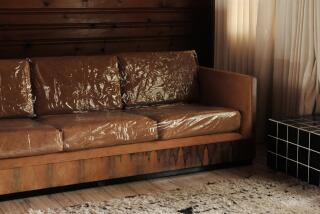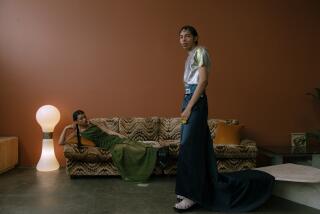FURNISHINGS : When You Have to Sink Money Into a Sofa, Be Sure to Shop for Shape
- Share via
Arise, couch potatoes! It’s time to shop for a new sofa. But beware: The ultimate goal may be comfort and relaxation, but the search calls for energy and synapse-snapping decisions.
Sectional, two-seater or three? Skirted or exposed wood frame? Hump back or straight back? Fat arm or thin--or no arms? And what kind of cover--solid, woven or printed pattern? Leather, linen, cotton or synthetic?
Over the past decade, backs have gotten higher and cushioning has gotten progressively thicker, plumping from three or four inches in the 1950s to eight to 10 inches today, said New York furniture designer John Mascheroni.
And most sofas fall into a few standard stylistic types. They include the club or Lawson, in which the arms are lower than the back; the Tuxedo, in which the arms and back are the same height, and the camelback, which has a hump in the middle.
“People get very frustrated because they have an idea of the sofa that they are looking for and they can’t find it,” said Fayal Greene, author of “The Couch Book,” (Hearst Books, William Morrow, 1993, $20). “They may walk right past what they want without recognizing it because the same frame can look quite different, depending on shape, length, fabric, arm type, cushion filling and other details.”
Greene advises shopping for shape and in the desired price range, without necessarily worrying too much about the sofa’s specific dimensions, covering and such stylistic details as whether the piece has a skirt or lacks one.
As a rule, the frame selected can be made up in a variety of ways.
“Many manufacturers offer options that go beyond what’s on the sales floor,” Greene said. “There are also many choices of fabric.”
The covering has the greatest effect on how a sofa looks and how it contributes to the decor. Any shape looks more modern if it’s covered in a neutral contemporary fabric, Mascheroni said. The same frame with a reproduction fabric takes on a traditional feeling.
The shape of the arms also is a key element in both looks and function. Those who like to stretch out for a nap or to watch TV should select a sofa with a wide, curving arm that is thickly and softly upholstered, Greene said.
Wide arms make the sofa look bigger. Even though the difference may be only a few inches, pieces with straight, thin arms look less obtrusive. For the least obtrusive effect, select an armless piece. People think they have more room on an armless sofa, and so they will sit closer together.
Looks may be deceiving. The soft squashy sofas that are low to the floor may appear just right for couch potatoes, but they are not necessarily more comfortable than tailored pieces on which you sit higher.
Many people are more comfortable on a firm seat, where you don’t sink in so deep, Greene said. Furthermore, all-down construction, by far the most expensive, is uncomfortable for some people because of that old sinking feeling.
Don’t give up on an old sofa. Perhaps the least expensive way to get an attractive new piece is to have it recovered by an upholsterer.
The simplest change is merely to change the fabric with slipcovers. Reupholstery offers even more options. Vary the skirt style to make a bigger difference in looks. Tightly woven fabrics, whether natural or synthetic fiber, stand up to more wear. Prints and medium to darker colors show the dirt less.
New cushions can be made thicker or thinner than the original. Minor changes to frame and padding can fatten or slenderize the silhouette and, if needed, the spring system can be repaired or replaced.
A less expensive quick fix is to add new throw cushions in different shapes, sizes and fabrics to draw attention away from what’s underneath.


